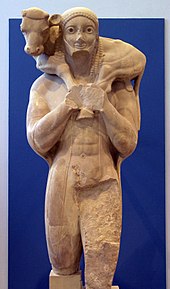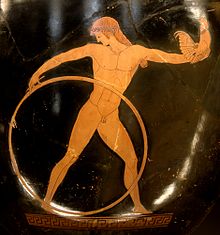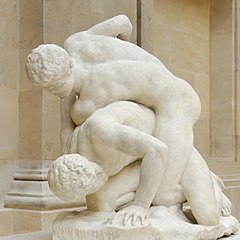History of nudity: Difference between revisions
Hairy Dude (talk | contribs) m →Recent history: avoid contractions |
Hairy Dude (talk | contribs) "see also" is for sections, not articles - use the "see also" section for that |
||
| Line 1: | Line 1: | ||
{{globalize/West|date=November 2010}} |
{{globalize/West|date=November 2010}} |
||
[[File:Ägyptischer Maler um 1400 v. Chr. 001.jpg|thumb|300px|Women entertainers perform at a celebration in Ancient Egypt; the dancers are naked and the musician wears a typical pleated garment as well as the cone of perfumed fat on top of her wig that melts slowly to emit its precious odors; both groups wear extensive jewelry, wigs, and cosmetics; neither wear shoes - ''Thebes tomb c. 1400 B.C.'']] |
[[File:Ägyptischer Maler um 1400 v. Chr. 001.jpg|thumb|300px|Women entertainers perform at a celebration in Ancient Egypt; the dancers are naked and the musician wears a typical pleated garment as well as the cone of perfumed fat on top of her wig that melts slowly to emit its precious odors; both groups wear extensive jewelry, wigs, and cosmetics; neither wear shoes - ''Thebes tomb c. 1400 B.C.'']] |
||
:''See also [[Timeline of non-sexual social nudity]]''. |
|||
The '''history of nudity''' refers to social attitudes to [[nudity]] in different cultures in history. |
The '''history of nudity''' refers to social attitudes to [[nudity]] in different cultures in history. |
||
Revision as of 23:18, 10 January 2012

The history of nudity refers to social attitudes to nudity in different cultures in history.
The wearing of clothing is exclusively a human characteristic and is a feature of most human societies. It is not known when humans began wearing clothes. Anthropologists believe that animal skins and vegetation were adapted into coverings as protection from cold, heat and rain, especially as humans migrated to new climates; alternatively, covering may have been invented first for other purposes, such as magic, decoration, cult, or prestige, and later found to be practical as well.
However, many cultures have at times been relaxed dispensing with clothing, at least for some purposes or in some situations.
Paleolithic history
Because animal skins and vegetable materials decompose readily there is no direct evidence of when and how clothing developed. However recent studies of human lice suggest that clothing may have become commonplace in human society around 72,000 years ago.[1] Some anthropologists believe that Homo habilis and even Homo erectus may have used animal skins for protection placing the origins of clothing at perhaps a million years or more.[2] It is not clear at what point modesty with respect to nudity became a part of human customs.
Ancient Egypt
Fashions in ancient Egypt did not change much over the millennia. The ancient Egyptians wore the minimum of clothing. Men were commonly bare chested and barefoot. They wore a tunic around their waist. Women commonly wore a loose draped fabric. Women entertainers performed in the nude. Children went without clothing until puberty, at about age 12.[3]
Though the minimum amount of clothing was the norm in ancient Egypt, the custom was viewed as humiliating by other ancient cultures. For example, the Hebrew Bible records: "So shall the king of the Assyrians lead away the prisoners of Egypt, and the captivity of Ethiopia, young and old, naked and barefoot, with their buttocks uncovered to the shame of Egypt".[4] Similar images occur on many bas-reliefs, also from other empires.
Ancient Greece


Throughout history, soldiers were commonly expected to provide their own clothing, and poverty forced some warriors and sailors to be without clothing.[5]
Ancient Greece had a particular fascination for aesthetics, which was also reflected in clothing or lack thereof. Sparta had rigorous codes of training and physical exercise in the nude. Athletes would compete in the nude in public sporting events. Spartan women, as well as men, would sometimes be nude in public processions and festivals. In the case of women, this practice was designed to encourage virtue while the men were away at war.[6]
In general, however, concepts of either shame or offense, or the social comfort of the individual, seem to have been deterrents of public nudity in the rest of Greece and the ancient world in the east and west, with exceptions in what is now South America, and in Africa and Australia. Polybius asserts that Celts typically fought naked, "The appearance of these naked warriors was a terrifying spectacle, for they were all men of splendid physique and in the prime of life."[7]
In antiquity even before the Classical era, e.g. on Minoan Crete, athletic exercise was an important part in daily life. In fact, the Greeks credited several mythological figures with athletic accomplishments, and male gods (especially Apollo and Herakles, patrons of sport) were commonly depicted as athletes.
Nudity in sport was very common[citation needed]. As a tradition it was probably first introduced in the city-state of Sparta, during the late archaic period.[citation needed]
In some ancient Mediterranean cultures, even well past the hunter-gatherer stage, such as Minoan[citation needed], athletic and/or cultist nudity of men and boys –and rarely, of women and girls– was a natural concept.

The civilization of ancient Greece (Hellas), during the Archaic period, had an athletic and cultic aesthetic of nudity which typically included adult and teenage males, but at times also boys, women and girls. The love for beauty had included also the human body, beyond the love for nature, philosophy, the arts etc. The Greek word gymnasium means "a place to train naked". Male athletes competed nude, but most city-states of the time allowed no female participants or even spectators at those events, Sparta being a notable exception.
Nudity in religious ceremonies was also practiced in Greece. The statue of the Moschoforos (the "Calf-bearer", image left), a remnant of the archaic Acropolis of Athens, depicts a young man carrying a calf on his shoulders, presumably taking the animal to the altar for sacrifice. Interestingly enough, the Moschophoros is not completely nude: a piece of very fine, almost transparent cloth is carefully draped over his shoulders, upper arms and front thighs, which nevertheless left his genitals purposely exposed. In this case the garment apparently fulfilled a purely ceremonial, priestly function in which modesty was not an issue.
In Greek culture, depictions of erotic nudity were considered normal. The Greeks were conscious of the exceptional nature of their nudity, noting that "generally in countries which are subject to the barbarians, the custom is held to be dishonourable; loves of youths share the evil repute in which philosophy and naked sports are held, because they are inimical to tyranny;"[8] In both ancient Greece and ancient Rome, public nakedness was also accepted in the context of public bathing. It was also common for a person to be punished by being partially or completely stripped and lashed in public; in some legal systems judicial corporal punishments on the bare buttocks persisted up to or even beyond the feudal age, either only for minors or also for adults, even till today but rarely still in public. In Biblical accounts of the Roman Imperial era, prisoners were often stripped naked, as a form of humiliation.

Nudity in sport spread to the whole of Greece, Greater Greece and even its furthest colonies, and the athletes from all its parts, coming together for the Olympic Games and the other Panhellenic Games, competed naked in almost all disciplines, such as boxing, wrestling, pankration (a free-style mix of boxing and wrestling, serious physical harm allowed) -in such martial arts equal chances in terms of grip and body protection require a non-restrictive uniform, as presently common, or the bare-, stadion and various other foot races including relay race, and the pentathlon (made up of wrestling, stadion, long jump, javelin throw and discus throw). However, they did not always perform in the nude during chariot races.
It is believed to be rooted in the religious notion that athletic excellence was an ‘esthetical’ offering to the gods (nearly all games fitted in religious festivals), and indeed at many games it was the privilege of the winner to be represented naked as a votive statue offered in a temple, or even to be immortalized as model for a god's statue. Performing in the nude certainly was also welcome as a measure to prevent foul play, which was punished publicly on the spot by the judges (often religious dignitaries) with a sound lashing, also endured in the bare.
Evidence of Greek nudity in sport comes from the numerous surviving depictions of athletes (sculpture, mosaics and vase paintings). Famous athletes were honored by a statue erected for their commemoration (see Milo of Croton). A few writers have insisted that the athletic nudity in Greek art is just an artistic convention, finding it unbelievable that anybody would have run naked. This view could be ascribed to late-Victorian prudishness applied anachronistically to ancient times. Other cultures in antiquity did not practice athletic nudity and condemned the Greek practice[citation needed]. Their rejection of naked sports was in turn condemned by the Greeks as a token of tyranny and political repression[citation needed].

In Hellenistic times, Greek-speaking Jews would sometimes take part in athletic exercises. They were then exposed to ridicule because they were circumcised - a national and religious custom which was unknown in the Greek tradition. In fact the Greek athletes, even though naked, seem to have made a point of avoiding exposure of their glans, for example by infibulation, or wearing of a kynodesme.
Roman empire
The Romans, although they took over much of the Greek culture, had a somewhat different appreciation of nakedness. To appear nude in public was considered inappropriate except in certain places and contexts: the public baths (originally open to both sexes) and even public latrines were as popular meeting places for all as the forum.
Athletic exercises by free citizens (no longer required to serve as soldiers since Marius' army reform)[citation needed] were partly replaced by gladiatorial games performed in amphitheatres. The gladiators were mainly recruited among slaves, war captives and death row convicts – the very lowest, who had no choice – but occasionally a free man chose this fast lane to fame and riches. When fighting in the arena, against one another or against wild beasts, they would be armed with swords, shields etc., but would otherwise be partly or totally naked (see Gladiator for particulars).
In Roman-occupied Jerusalem, Jews using the gymnasium would wear prosthetic foreskins made from sheep gut in order to avoid being ridiculed for being circumcised[citation needed].
Gladiatorial contests were one of many features, especially religious, that Rome inherited from its Etruscan neighbours. This ancient, non Indo-European (possibly originating from Asia Minor) culture even depicts warriors fighting completely naked[citation needed].
Japan
Sumo wrestling, practiced by men in ceremonial dress of loin cloth-size that exposes the buttocks like a jock strap, in general is considered sacred under Shintō. Public, communal bathing of mixed sexes also has a long history in Japan.
Traditional cultures
In some hunter-gatherer cultures in warm climates, near-complete nudity has been, until the introduction of Western culture, or still is, the social norm for both men and women. In some African and Melanesian cultures, men going completely naked except for a string tied about the waist are considered properly dressed for hunting and other traditional group activities. In a number of tribes in the South Pacific island of New Guinea, men use hard gourdlike pods as penis sheaths. Yet a man without this "covering" could be considered to be in an embarrassing state of nakedness. Among the Chumash people of southern California, men were usually naked, and women were often topless. Native Americans of the Amazon Basin usually went nude or nearly nude; in many native tribes, the only clothing worn was some device worn by men to clamp the foreskin shut. However, other similar cultures have had different standards. For example, other native North Americans avoided total nudity, and the Native Americans of the mountains and west of South America, such as the Quechuas, kept quite covered.
Ibn Battuta (1304–1369) judges the character of the people of Mali:
Among their bad qualities are the following. The women servants, slave-girls, and young girls go about in front of everyone naked, without a stitch of clothing on them. Women go into the sultan's presence naked and without coverings, and his daughters also go about naked.[9]
In 1498, at Trinity Island, Trinidad, Christopher Columbus found the women entirely naked, whereas the men wore a light girdle called guayaco. At the same epoch, on the Para Coast of Brazil, the girls were distinguished from the married women by their absolute nudity. The same absence of costume was observed among the Chaymas of Cumaná, Venezuela, and Du Chaillu noticed the same among the Achiras in Gabon.[10]
Recent history
During the Victorian era, public nakedness was considered obscene. In addition to beaches being segregated by gender, bathing machines were also used to conceal the naked body. In the early 20th century, exposure of male nipples was considered indecent at some beaches. This is in contrast to in the Middle Ages, when the bathing suits worn by men, while covering the genitals, often nonetheless made them quite obvious.
Sport in the modern sense of the word became popular only in the 19th century. Nudity in this context was most common in Germany and the Nordic countries, where Body culture was very much revered (and some say, copied) by Nazi ideologues[citation needed].
In 1924, in the Soviet Union, an informal organisation called the "Down with Shame" movement held mass nude marches in an effort to dispel earlier, "bourgeois" morality.[11][12] [13]
In the Nordic countries, with their sauna culture, nude swimming in rivers or lakes was a very popular tradition. In the summer, there would be wooden bathhouses, often of considerable size accommodating numerous swimmers, built partly over the water; hoardings prevented the bathers from being seen from outside. Originally the bathhouses were for men only; today there are usually separate sections for men and women. For the Olympic Games in Stockholm in 1912, the official poster was created by a distinguished artist. It depicted several naked male athletes (their genitals obscured) and was for that reason considered too daring for distribution in certain countries. Posters for the 1920 Olympics in Antwerp, the 1924 Olympics in Paris, and the 1952 Olympics in Helsinki also featured nude male figures, evoking the classical origins of the games. The poster for the 1948 London Olympics featured the Discobolus, a nude sculpture of a discus thrower.
An occasional—often illegal—naked sideshow is when a member of the public uses a sports venue to perform as a streaker. Streaking became more popular in the 1970s. It was not until the 1990s (and after) that nudity became expected at major public events, such as Bay to Breakers and World Naked Bike Ride.
See also
- Christian naturism
- American Gymnosophical Association
- Depictions of nudity - Also discusses depictions of nudity in general.
- List of social nudity places - Beaches, resorts, public parks and communities.
- Nudity and sexuality
- Nudity in combat
- Nudity in religion
- Nudity in sport
- Public nudity
- Timeline of non-sexual social nudity
References
- ^ Arney, Kat, "Head lice key to clothing history", BBC News, 29 September 2003 [1]
- ^ Sneed, Joe, "LISS.398A TECHNOLOGY, ENVIRONMENT and HUMAN ADAPTATION: PART I EARLY PEOPLES in the NEW WORLD", Colorado School of Mines, retrieved 1 Dec 2007 [2]
- ^ Manuelian, Peter Der (1998). Egypt: The World of the Pharaohs. Bonner Straße, Cologne Germany: Könemann Verlagsgesellschaft mbH. ISBN 3-89508-913-3, pp. 406–7
- ^ Isaiah 20:4
- ^ Chris Fitter, ELH 72 (2005) Emergent Shakespeare and the Politics of Protest: 2 Henry VI in Historical Contexts, p. 136
- ^ Plutarch's lives, the Life of Lycurgus.
- ^ Polybius, Histories II.28
- ^ Plato, Symposium; 182c
- ^ Ibn Battuta - The Great Traveller
- ^ Dr. Jacobus X : Untrodden Fields of Anthropology. Falstaff Press, NY, 1937. vol. 2, p. 183 (Accessible online: here)
- ^ Siegelbaum, Lewis H. Soviet state and society between revolutions, 1918-1929. ISBN 978-0521369879.
- ^ Hamburg, Gary. Rise and Fall of Soviet Communism. The Teaching Company. ISBN 978-0102250244.
- ^ Russia: Down With Shame, Time Magazine, September 22, 1924.
Sources and references
- Carr-Gomm, Philip, "A Brief History of Nakedness", Reaktion Books 2010 ISBN 978-1861896476
- Rouche, Michel, "Private life conquers state and society", in A History of Private Life vol I, Paul Veyne, editor, Harvard University Press 1987 ISBN 0-674-39974-9
- Etymology OnLine- various lemmate & [3]
External links
- Nudity in art Today by Art Lister
- 20 century Nude in the "History of Art"
- Nudity in Ancient to Modern Cultures by Aileen Goodson (This chapter excerpt is from Aileen Goodson's Therapy, Nudity & Joy)
